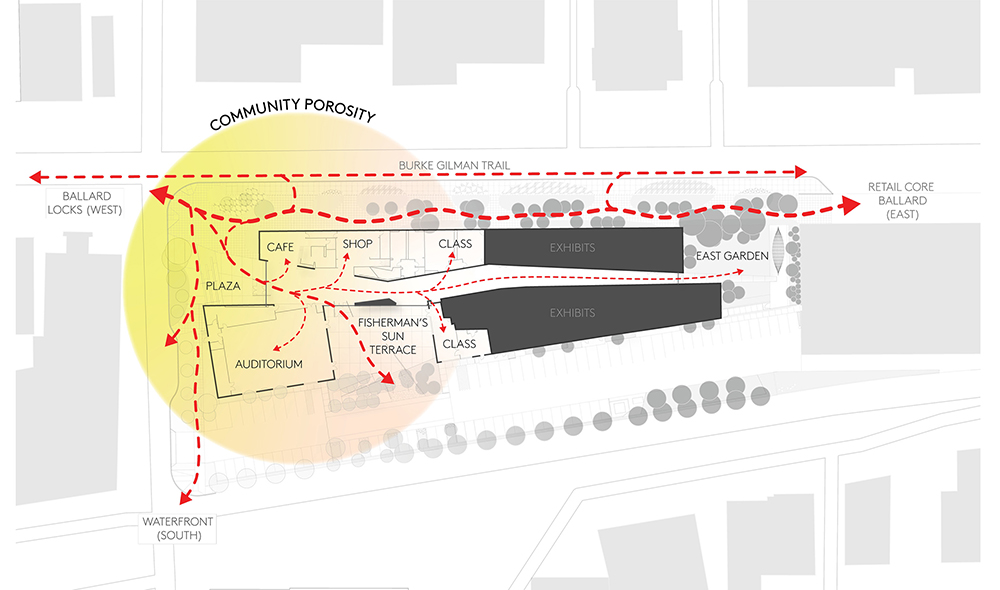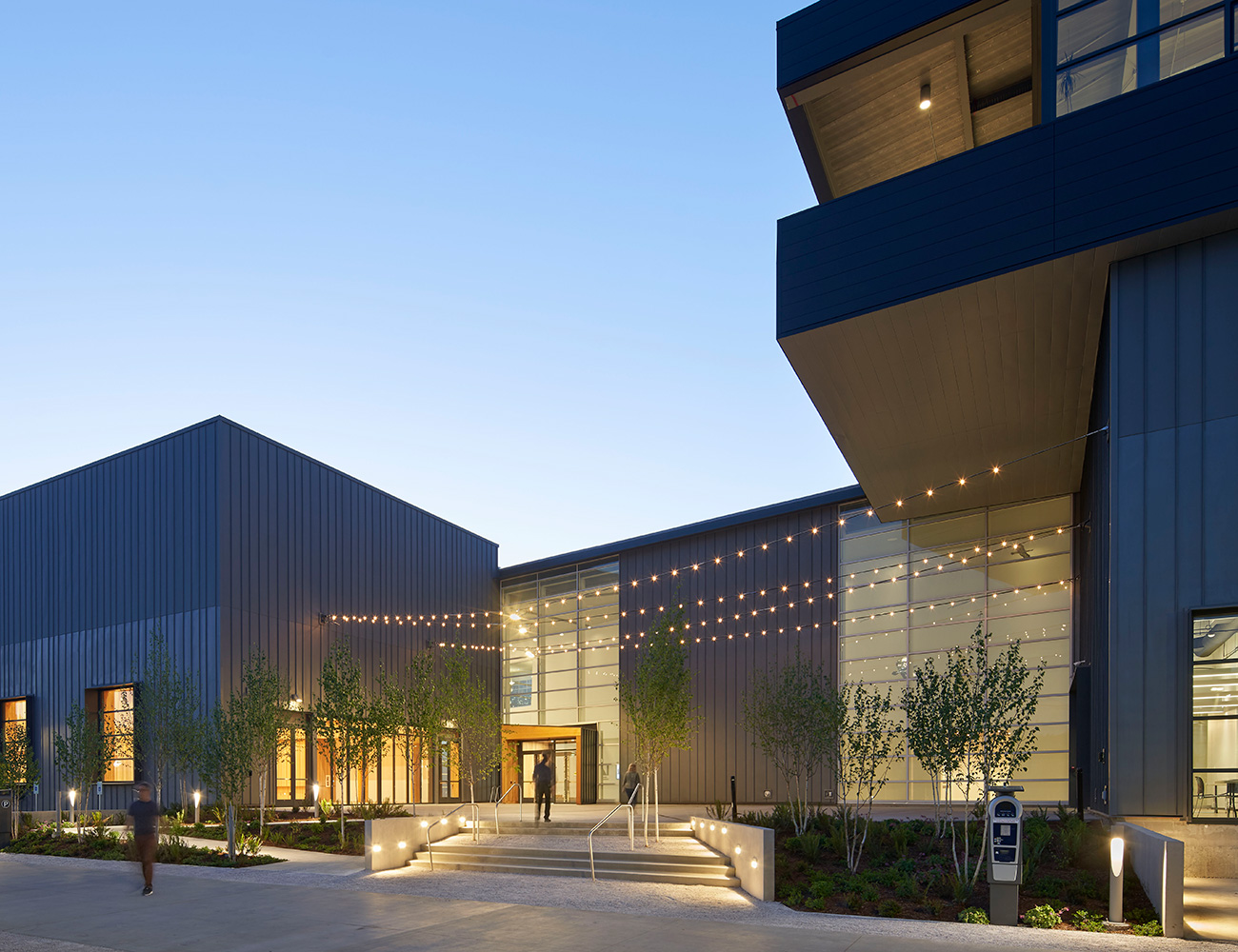Date Posted: 09.10.2020
The National Nordic Museum is a cultural touchstone in the heart of Seattle’s Ballard neighborhood, and a connection between traditional Nordic culture and Nordic America. At the turn of the 20th century, one out of every four immigrants to Washington state came from the Nordic countries of Denmark, Finland, Iceland, Norway and Sweden. Many settled in Ballard, where they joined the booming maritime and forestry industries and had a significant influence on Pacific Northwest (PNW) development. The Nordic Museum is the only museum in the world dedicated to telling the story of the five Nordic countries and the native Sami people; it is a home for the vital and lasting connections between the Nordic and PNW regions.
Aligned with the National Nordic Museum’s mission to serve as a welcoming community gathering space to all people, the plazas and gardens of the Museum invite neighbors and visitors to linger in both the indoor and outdoor common areas by creating connected, generous non-ticketed program areas throughout the project. The design for the Museum site and building seamlessly ‘foregrounds’ community space by intentionally situating public amenities front and center. The National Nordic Museum offers varied programming—cutting-edge music performances, traditional craft making, films, traditional lifeways classes, special exhibitions and public discussions such as ‘Social Justice Fika (coffee social) Pop Ups’ and ‘Social Justice in Contemporary Danish Photojournalism’ an exhibit addressing public consequences of global cities gripped by unacceptable levels of air pollution and the ‘Skin Close’ series that highlights one photojournalist’s meticulous documentation of homelessness in Copenhagen.

A well-established institution, founded in 1980 and previously located in a historic schoolhouse in North Ballard, the Museum moved in 2018 to the new site at the center of the neighborhood, stitching together Ballard’s working waterfront with its retail core and significantly completing the “missing link” of the regional multi-modal Burke-Gilman trail that was previously severed from Shilshole Bay and the Salish Sea to the west.
CONNECTION TO NATURE AND CULTURE
Open Air Living
Connection to nature is a value inextricably linked to Nordic culture and is also widely valued by Pacific Northwesterners. The Museum’s design team was inspired by the concept of friluftsliv (free-loofts-liv) which translates as “open-air living”—a concept defined by the Norwegian playwright and poet Henrik Ibsen to describe the value of spending time in the natural world, in order to support a restorative experience of mind and body. The landscape from east to west is a gradient of bioregions shared by the Nordic countries and the PNW. Approaching from the retail core east of the site, visitors experience planting designed to evoke cool, shady forests, which slowly transition to open, sunny meadows lush with nodding seed heads of grasses and airy wildflowers as visitors approach the Entry Plaza and front door of the museum.
Playful Streetscape and Civic Gain
The streetscape of undulating shapes in the ground plane conjures the shared archipelago landforms that are endemic to both Nordic and PNW regions, while simultaneously reflecting the playful geometries of iconic 20th century Nordic textile and sculpture designs. These boldly shaped planted areas create a new, sinuous path along a generous 33-foot-wide sidewalk and shared-use trail experience. Jarrah wooden benches (FSC), simple bicycle racks and special Poulsen pedestrian lights dot the sidewalk in front of the Museum, creating gathering spaces in the alcoves adjacent to paths of travel. Working in close collaboration with the Museum and the Seattle Department of Transportation to narrow the roadway in front of the Museum, this significant civic improvement claims more of the street right-of-way for pedestrians, and further connects Ballard’s retail core with the Museum and Seattle’s beloved beaches and coastal parks to the west.

A Seamless ‘Fjord’ Expression
Expressed in two volumes with a large open ‘Fjord Hall” that extends into the site, the 57,000-square-foot building form is inspired by the parallel histories of Nordic countries and Nordic America, and the transatlantic relationship that began with 10th century Vinland journeys and mass 19th century immigration, and continues today with arts and technology interchange. Between these two volumes, the 325-foot-long Fjord Hall connects community galleries at the first floor and, on the second, becomes the ‘divider’ between the permanent collections—Nordic galleries to the north and the story of Nordic America to the south. Fjord Hall is flanked by large, faceted planes that abstractly evoke the mythic geologies of the Nordic and PNW worlds.
The Entry Plaza extends Fjord Hall outside, serving as the ‘mouth’ of the fjord as if the water has spilled out of the museum doors and begins to meet the open seas beyond. The public realm blurs from the sidewalk to the plaza, subtly shifting in paving pattern and serving as a ceremonial terrace for events like the Museum’s 2018 ribbon-cutting with Iceland President Guðni Thorlacius Jóhannesson and Her Royal Highness Mary the Crown Princess of Denmark.
Working Waterfront in Action
A second entrance and gathering space that connects the public areas of the Museum is the Fisherman’s Sun Terrace, located outside of the Osberg Great Hall auditorium with access to the shoreline. The fishing industry and working waterfront, fully displayed from this terrace, is approached along a circuitous path through a grove of multi-stem birch trees harkening to journeys through forested hillsides endemic within Nordic landscapes. Here visitors experience geologic landforms that flank the iconic fjords such as Pulpit Rock in Norway. Glass folding doors seamlessly blend interior and exterior, accommodating events and flexible ‘spillout’ from adjacent classrooms and the auditorium. Catenary lights crisscross overhead, creating a festive atmosphere with optional tenting for large community events.

Contemplative Interpretation
The East Garden counterpoints the Entry Plaza, extending the interior expression of the ‘Fjord Hall’ and museum exhibits into a quiet courtyard garden with art and artifacts, culminating in a dragon masthead of a replica Viking boat. The simple meadow lawn of the East Garden, inspired by lush horse pastures of farms in Finland and the Northwest, features a runestone and the only original Finnish sauna currently functioning in the U.S.
This garden is bordered by coniferous trees, evocative of the Nordic forests, with an underplanting of edible berries common in Nordic cuisine, such as lingonberry (Vaccinium vitis-idaea) and huckleberry (Vaccinium ovatum). During springtime, visitors may catch a glimpse of Twinflower (Linnea borealis), a shy native plant of the PNW and the unofficial national flower of Sweden, and, peeking out from behind the runestone, a row of Astrantia major ‘Star of Royal’, known to have graced the garden of the late notable Danish author, Karen Blixen.
Ecological Sensitivity
Reflecting the global leadership of Nordic countries for innovative sustainability strategies and in keeping with the City of Seattle’s rigorous sustainability metric, ‘Greenfactor’ (which requires that at least 30% of the 80,000-square-foot site be pervious), large native planting beds punctuate the site and roof. With sensitivity to the surrounding endangered salmon habitat that has been adversely affected by rising water temperatures due to climate changes, site stormwater runoff is filtered by bioretention cells planted with natives or is filtered through the pervious asphalt parking lot to modular wetland treatment systems. The project achieved LEED Gold certification.
INTERSECTION OF HISTORY AND HIPSTERS
As Executive Director Eric Nelson mentioned in his remarks at the Museum’s opening ceremony in 2018, “Our front doors open to shops and restaurants, our back door to the working waterfront. The Museum stands at the intersection of history and hipsters.” The National Nordic Museum bridges the previously disjointed areas of Ballard and creates an open and thriving destination that seeks to welcome all.
This article is adapted from an article that originally appeared in Nordic Kultur, the magazine of the National Nordic Museum. Visit the online Museum Store to order a printed copy.